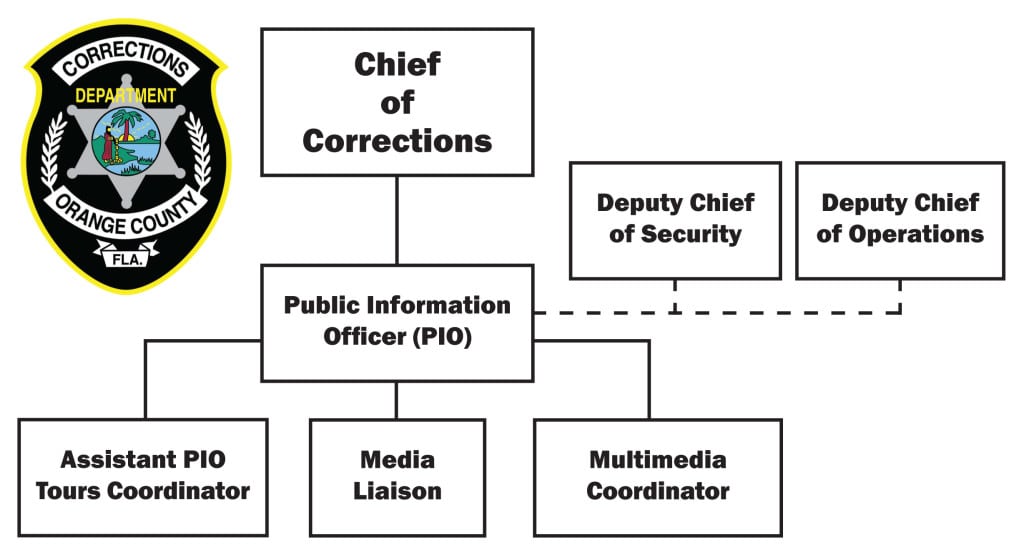

In the not-too-distant past, the Office of Public Information at the Orange County (FL) Corrections Department (OCCD) functioned with only a single public information officer (PIO) and a back-up media relations person. The back-up staffer was a correctional officer trained in media relations. The officer served as a duty PIO when the primary PIO was away or unavailable due to other projects. Previously the PIO had an assistant, but that position fell into a long-term vacant status while it was being reclassified.
A few factors provided the office with the impetus to evolve into its new and improved structure. A new chief of corrections, who was appreciative of the role of communications, was appointed. Second, a series of high-profile cases prompted a media frenzy that taxed the ability of the office to quickly respond to press inquiries. The need to provide comprehensive information on a wide range of functional areas within the organization, combined with the sheer volume of information of interest to the media, drove the decision to diversify the roles of communications.
Committed to open communication, the organization needed a structure to provide transparent and precise information about its operations.
Finding The Right Formula
The assistant position was reclassified to serve as assistant PIO and tours coordinator for the agency. Having a position dedicated to providing facilities tours and doing outreach enabled the Department to expand its goal of weaving itself more tightly into the fabric of the community. In the last year alone, nearly 700 people have toured the jail. These have included criminal justice classes, citizen groups, elected officials and representatives from jails in other areas.
The duty PIO became a full-time position in the Public Information Office with the new title of media liaison. This full-time staffer is dedicated to dealing with the daily deluge of media requests for arrest affidavits, booking photos and more.
Having this full-time position in place also allows the PIO to deal with high-profile events, providing PR counsel to senior leadership, outside projects and overall management of the office. In addition, it frees the PIO to be more proactive and responsive in dealing with the media.
The ability to be more responsive to media queries has been a benefit on many levels. For example, the PIO has been free to pitch stories about good things happening at the jail, including programs to help inmates succeed as law-abiding citizens upon release. In recent months, we have landed two such stories on page 1 of the Orlando Sentinel. For a story on our Inmate Construction program, we pitched the higher education reporter and offered her rare access to our secure compound to report the story. For a p. 1 story on our Vivitrol initiative for heroin-addicted inmates, we pitched the county beat reporter who had been covering a heroin task force.
Another takeaway: Under the reorganized structure we’ve been more consistently available to the media under good circumstances and bad. This ultimately has improved our position when pitching the positive stories described above.
To exploit the benefits of a changed media environment, a multimedia coordinator position was transferred from the Corrections Department’s training unit to the Public Information Office. Having this position allows for the development of multimedia projects, including news packages for the county’s online media center, videotaping of department events and producing staff and inmate training videos. These include informational video loops shown on the booking floor and inmate orientation pieces.
With the multimedia coordinator, the Public Information Office now is able to provide materials not only in print but also in various digital formats, such as video, audio, text and online. The position serves as staff photographer, which is essential for publishing a highly visual employee newsletter each month. The multimedia coordinator also is responsible for updating the website, bestjail.com.
A Seat At The Table
The PIO is a direct report to the Chief of Corrections (see org chart). This is essential because corrections is a crisis-prone profession, and wise communication counsel needs to be available when disaster strikes.

In terms of employee communications, the public relations professionals also set the tone of what information is being communicated within the organization. The org chart shows the PIO also has dotted-line reporting to both deputy chiefs. This is critical to access real-time information on jail incidents, and it allows the PIO to follow up with them directly for the full story. A complex, multi-facility organization like OCCD needs to have both direct and indirect reporting structures to best utilize limited resources and meet the media’s and the public’s needs.
A Sound Solution
Increasing the size and expanding the outreach of Orange County’s Corrections Department made sense in serving the needs of the media and the public. The now-centralized communication model better fosters staff efficiency as well as consistent messaging across the organization.
The restructured department allows the team to more effectively respond to media requests for information on Corrections matters. It has also gone a long way in building effective relationships with our media partners. The office has earned a solid reputation for providing rapid responses to media. And with the addition of the multimedia coordinator, we can more fully embrace digital opportunities.
OCCD is committed to effective communication to support its operational goals and meet commitments to the Orange County community. The overarching goal is always to provide open access to the correct sources for the information needs of both the press and the public.
CONTACT: [email protected]
